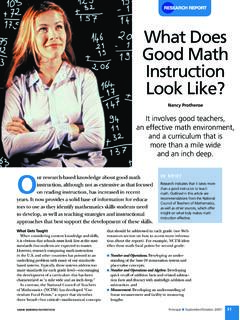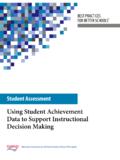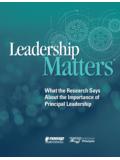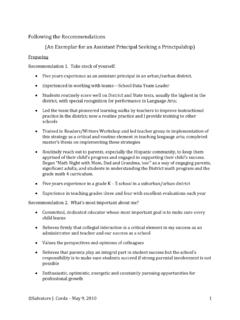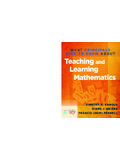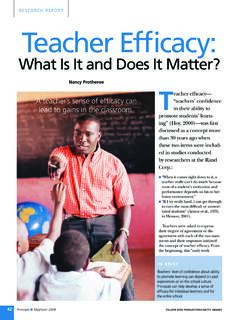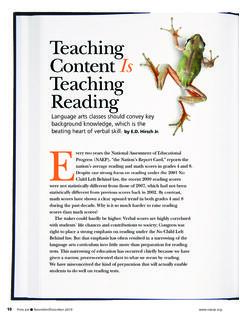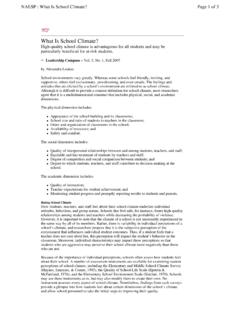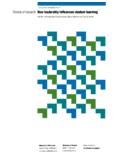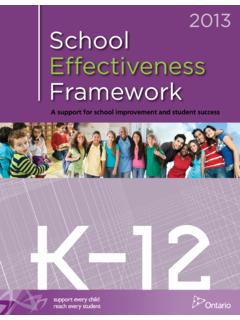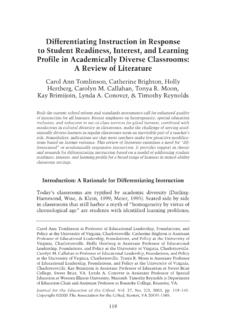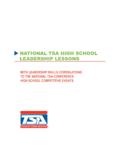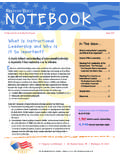Transcription of Professional Learning Communities Impact Student Success
1 Professional Learning Communities Impact Student Success This school uses a Professional Learning community to target students needs. leadership Compass Vol. 5, No. 2, Winter 2007 by Erin R. Rentfro The Professional Learning community (PLC) model gives schools a framework to build teacher capacity to work as members of high-performing, collaborative teams that focus on improving Student Learning . According to Eaker, DuFour, and DuFour (2002): The framework of the Professional Learning Community model can be put into three themes. The school has to have a solid, shared mission, vision, values, and goals; collaborative teams that work interdependently to achieve common goals; and a focus on results as evidenced by a commitment to continuous improvement.
2 Schools doing this work have clarity of purpose and a collaborative culture, are able to turn collective inquiry into a best practice and examine current reality, are action oriented and committed to continuous improvement, and have a strong principal who empowers teachers to be leaders (DuFour, DuFour, Eaker, & Karhanek, 2004). In a PLC school, teachers work together by writing common assessments, planning curriculum, and sharing teaching duties. Teachers often refer to students as our students instead of my students , reinforcing the collective atmosphere.
3 Teachers work together to identify at-risk students , and teams problem-solve to intervene for each Student . Due to increased accountability and the growing needs of students , South Elementary in Eldon, Missouri, decided that it would benefit from enacting a PLC. A leadership team was selected and attended training in the summer of 2003, and the implementation of the PLC began during the 2003-2004 school year. South Elementary promotes and fosters a sense of Learning for all students , and staff and teachers live by their shared mission, vision, and commitment statements.
4 During collaborative team meetings, teachers share their concerns, reflect on their teaching strategies, and make decisions based on data. The four critical questions of the PLC model that drive the conversations of grade-level meetings are: zWhat do we want students to learn? (Planning and pacing instruction) zHow will we know if they have learned it? (Collect data) zWhat do we do if they do not learn it? (Intervention) zWhat do we do if they do learn it? (Enrichment) Collaborative Teaching Teachers have two collaborative planning times each week. The first focuses on planning and pacing instruction and the second focuses on identifying and problem-solving for at-risk students .
5 All grade-level teams meet twice weekly to discuss each at-risk learner and to identify the instructional practices that provide the best results. South Elementary also has four literacy coaches who embed Professional development into the school by modeling effective practices in all classrooms, debriefing with teachers, and initiating deeper conversations with students and staff about Learning . Teachers and administrators participate in walkthrough observations in all classrooms to continue Learning and to improve instruction. Teachers also have a one-hour early release every Wednesday to meet in collaborative teams.
6 All grade-level teachers also have a daily, 45-minute common planning time. Every meeting is focused on the four critical questions about Student Learning . Each team maintains a notebook with all meeting agendas, lists of at-risk students , common assessments, grade-level expectations, and data used to monitor progress. Teachers share in the responsibilities for weekly collaborative meetings by taking turns planning, facilitating, and taking notes. Collaborative teams share agendas, minutes from meetings, and common assessment results with administrators.
7 The administrators rotate attendance during weekly collaborative Page 1 of 3 NAESP : Professional Learning Communities Impact Student Successplanning time. Professional development is provided throughout the year to improve the practices of highly effective collaborative teams. Student Learning and Assessment South Elementary works to monitor Student Learning by using frequent common assessments and progress monitoring so that teachers can identify students who need additional support. students are given the Developmental Reading Assessment three times a year in grades 1-3 and twice a year in kindergarten.
8 The Dynamic Indicator of Basic Early Literacy Skills is administered three times a year to all kindergartners and identifies at-risk readers in other grades. The Systematic Intervention in Phonics, Phoneme Awareness, and Sight Words assessment tool is given to all kindergartners starting in January, and to struggling readers starting in the fall. Collaborative teams meet three times per year with the administration. The first meeting is to review results of common benchmark assessments, identify at-risk students , and write goals and action steps to achieve goals.
9 The subsequent meetings are used to monitor progress, discuss concerns, brainstorm interventions, and celebrate successes. Progress is monitored Student by Student , and the results of all assessments determine the type and intensity of interventions to meet Student goals. Systematic interventions contribute significantly to Student Learning . Intervention time must be provided during the school day to be effective for all students . Each grade-level team sets targets based on grade-level expectations, a guide for pacing the curriculum, and common assessments with scoring guides to determine proficiency.
10 All grade levels have interventions at the same time so flexible grouping is possible across grade levels. During interventions, all staff members in the building are involved and work as a team to meet the needs of all children. PLC Successes The Impact of the PLC model on teaching and Learning has been phenomenal and we have seen growth as a whole. Missouri Assessment Program (MAP) data showed a percent gain in advanced and proficient scores for communication arts between 2001 and 2005. In addition, the percentage of first-grade students scoring on grade level on the Developmental Reading Assessment end-of-year test increased percent between 2001-2002 and 2006-2007.
